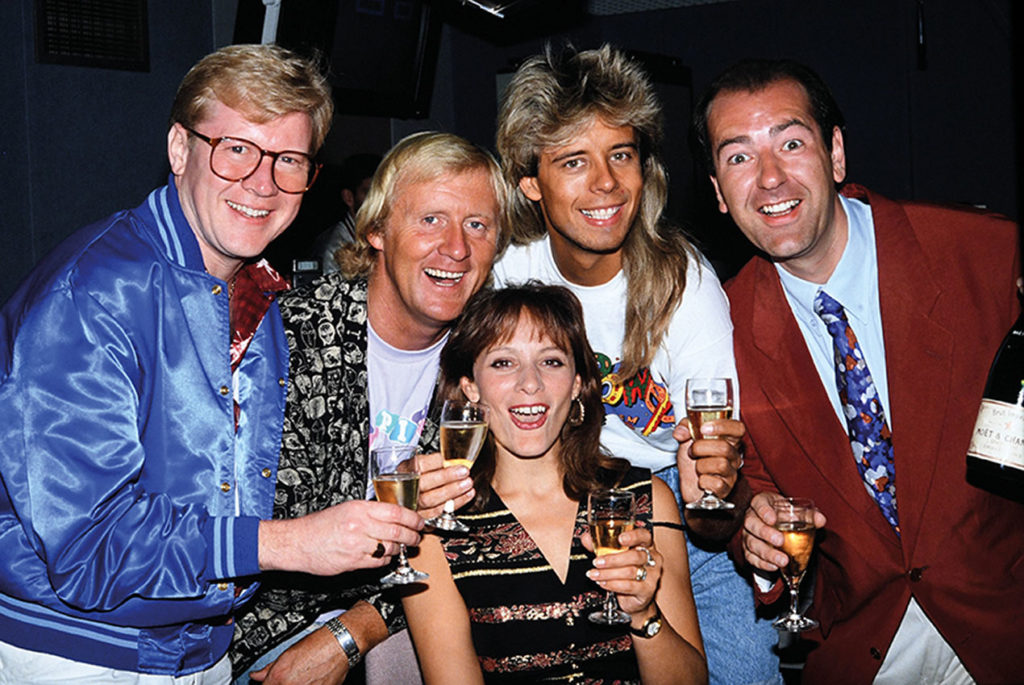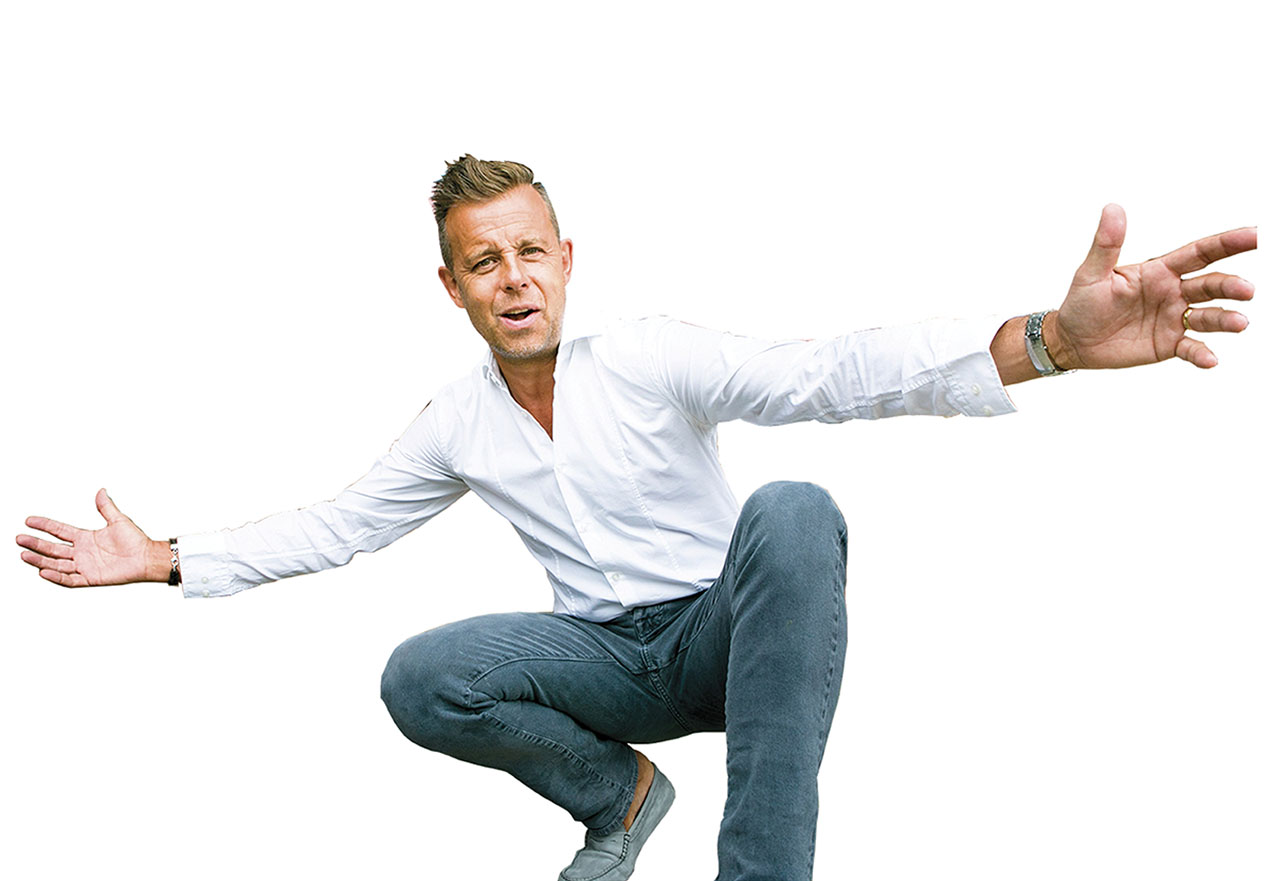Would Pat mullet over?
His new autobiography puts Pat Sharp at the centre of some of the biggest cultural events of the 1980s and 1990s. Whatever the truth of his exploits, he wouldn’t have done it any differently
Some things you may already know about Pat Sharp: he hosted Fun House, the 1990s children’s TV show that whizzed by in a garish haze of slime,
go-karting, and pom-pom wielding twins, with a showstopping denouement that looked like a Wacky Warehouse on steroids. He’s currently a DJ on Greatest Hits Radio, appeared on I’m A Celebrity… Get Me Out Of Here! in 2011, and pre-Tiger King’s Joe Exotic, he had the most recognisable mullet in pop culture.
“The irony is, although it’s the thing I’m synonymous with, I only ever spent one week a year doing Fun House.”
But according to the revelations in his new book, Re-Run The Fun: My Life As Pat Sharp, there are eyebrow-raising aspects of the 59-year-old’s life that may surprise you. Like a more elaborately-coiffured Forrest Gump, he’s been present at some defining moments in history. He convinced Spice Girl Geri Horner (nee Halliwell) to don her iconic Union Jack dress at the 1997 Brit Awards; a year earlier at the same ceremony, he’d dared Jarvis Cocker to invade the stage during Michael Jackson’s messianic performance. He suffered a coughing fit during the taping of an episode of Who Wants To Be A Millionaire?, and once remarked to the late Princess Diana that his distinctive hairstyle received so much attention, “it felt like there were three of us in this marriage so it was a bit crowded” – only to be surprised when the Princess of Wales used the exact same immortal line in her Panorama interview.
Oh, and he spent the 1990s snorting so much cocaine, it’s a wonder the Colombian National Anthem didn’t play every time he sneezed.
Of course, none of this is technically true but hey, let’s not split (lustrous blond mullet) hairs. Speaking down the phone from his home in Herefordshire, Sharp cheerfully describes his autobiography as a “sort of biography – based on an untrue story”. And referencing Fun House’s memorable theme tune: “It’s a whole lot of fun – without too many prizes to be won, but it’s very much a spoof for people who remember Fun House from their youth.”
Sadly, this means that, despite what is stated in the book, he didn’t break up a fight between Oasis and Blur, and Fun House didn’t experiment with guest directors such as kitchen-sink auteur Mike Leigh. So how did Sharp end up channeling his inner Alan Partridge and concocting the most WTF? pseudo-autobiography of 2020?
Sharp used to drive his children and their friends to school. One of his kids’ mates, Darren Richman – a hardcore Fun House fan – got in touch with Sharp decades later asking to write his autobiography. Instead, they alighted on the notion of a spoof history.
“I didn’t want it to be a straightforward autobiography – which most footballers’ have written three of by the time they’re 21,” he says. “This is a more interesting way of doing it. Everything I told Darren, and his co-writer [Luke Catterson], they said: ‘Wouldn’t it have been more fun if you’d done it this way?’ And we went with it.”

It’s a veritable Pun House! He throws wild parties in his “Patchelor pad” and beetles around in his “Patmobile”. But if you want any insight into the real Pat Sharp, you won’t find it here. Even simple details, like his parents’ occupations, are changed for comic effect.
Born Patrick Sharpin, he was educated at the public school Merchants Taylors’ in Northwood, but always wanted to be
a DJ. He would pretend to be ill and bunk off school to listen to the radio all day.
“I had a cassette radio and the best thing about it was it was made by Sharp – so it felt like it had my name on it. You could fade it down by turning a button, so I’d listen to the radio and do the intros to songs myself. That’s what I’d do with my schooldays – not great for someone who had a private education.”
At 18 he travelled to America, and imported that style of radio back to the UK, first as one of the youngest presenters on Radio 1, and at Capital FM in London. But it’s his 10-year stint as presenter of Fun House that he’s still best known for, and while it’s been 21 years since it departed from the TV schedules, vague plans are still afoot for its return as a live Crystal Maze-style interactive experience. “But the irony is, although it’s the thing I’m synonymous with, I only ever spent one week a year doing Fun House,” says Sharp. “I took a week off Capital instead of a holiday, and we did 14 shows a series – recording one in the morning, one in the afternoon.”
Even so, it’s capable of evoking a Proustian rush among those who were Pogs-collecting kids in the 1990s, says Sharp. “People see kids TV presenters from that time and remember what they were like when they didn’t have a mortgage or rent to pay – they were just happy to watch a brightly-coloured show while they had a bag of crisps and a Nesquik.”
Even former World Cup captains were transported back to being 10 years old when they met him, he recalls in a clearly well-worn anecdote.
“I was at a charity luncheon and I was beckoned over by Victoria Beckham, who said she enjoyed listening to me on the radio. Throughout the whole time, David Beckham was looking over her shoulder with a great big beaming smile on his face, and he just went: ‘Fun House. Loved it.’”
His popularity on Capital FM in the late 1980s led to an unexpected pop career, teaming up with fellow DJ Mick Brown as the duo Pat and Mick and releasing of charity singles – and one album – masterminded by production powerhouse Stock, Aitken, Waterman.
“It was strange to suddenly go to the studio and having fellow S/A/W acts like Kylie Minogue and Rick Astley passing by and probably doing the odd backing vocal for you. It was odd going on Top of the Pops pretending to be pop stars alongside Cliff Richard because I couldn’t sing. They used a lot of Autotune!”
But in 1989 Smash Hits magazine readers voted him number eight in a most very horrible thing poll – sandwiched between Aids at number seven and racism at nine – and his hair was a frequent target – not that Sharp minds.
“It was great publicity,” he laughs. “I remember being given the worst haircut award at the Smash Hits poll winners party multiple years running, but at the same time, I was also winning best DJ and most fanciable male.”
His barnet features prominently in the book. It jokes that the first record he played was by new wave group Haircut 100 and he once checked into rehab for an addiction to haircare products. In truth, his “business at the front, party at the back” style came from a visit to Norway when he was a VJ for the pan-European Sky Channel.
“All the guys there had ‘hockey hair’ – what they call a mullet because their ice hockey players wore it, so I started growing it into that Viking look. It was a successful trip – I picked up my hairstyle and met my wife of 34 years. I must have done something right because I’m still talking about it all these years later.”
Indeed, as the go-to presenter for all things retro (although Covid-19 has scuppered his live gigs this year), people flock to his live DJ appearances in nylon fright wigs. “If you type mullet wig into Google, the first thing that comes up is a Pat Sharp wig. I don’t get any money from it! All these years on, I’m grateful people are nothing but nice to me, whereas back in the 1980s and 1990s, there would be the odd guy shouting obscenities at you as you drove along with your personal numberplate, with your hair blowing in the wind, thinking you were pretty cool.”
Re-Run The Fun: My Life As Pat Sharp is published by Constable
